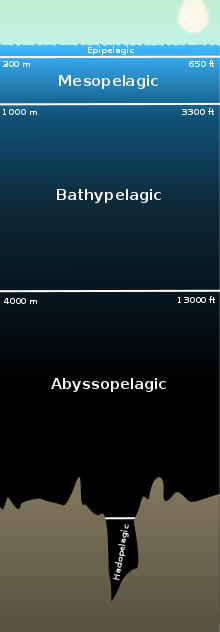Photic zone
The photic zone, euphotic zone, epipelagic zone or sunlight (or sunlit) zone is the uppermost layer of the ocean that receives sunlight, enabling it to perform photosynthesis. It undergoes a series of physical, chemical, and biological processes that supply nutrients into the upper water column. The photic zone is home to the majority of marine life, due to its location.
| Aquatic layers |
|---|
| Stratification |
| See also |

Photosynthesis in photic zone
In the photic zone, the photosynthesis rate exceeds the respiration rate. This is due to the abundant solar energy which is used as a food source for primary producers such as phytoplankton. These phytoplankton grow extremely quickly because of sunlight's heavy influence, enabling it to be produced at a fast rate. In fact, ninety five percent of photosynthesis in the ocean occurs in the photic zone. Therefore, if we go deeper, beyond the photic zone, such as into the compensation point, there is little to no phytoplankton, because of insufficient sunlight.[1] The zone which extends from the base of the euphotic zone to about 200 meters is sometimes called the disphotic zone.[2]
Life in the photic zone
Ninety percent of marine life lives in the photic zone, which is approximately two hundred meters deep. This includes phytoplankton (plants), including dinoflagellates, diatoms, cyanobacteria, coccolithophorids, and cryptomonads. It also includes zooplankton, the consumers in the photic zone. There are carnivorous meat eaters and herbivorous plant eaters. Next, copepods are the small crustaceans distributed everywhere in the photic zone, and are actually the biggest group of animals on the planet. Finally, there are nekton (animals that can propel themselves, like fish, squids, and crabs), which are the largest and the most obvious animals in the photic zone, but their quantity is the smallest among all the groups.[3]
The depth of the photic zone depends on the transparency of the water. If the water is very clear, the photic zone can become very deep. If it is very murky, it can be only fifty feet (fifteen meters) deep.
Photic zone depth
The depth is, roughly, where radiation is degraded down to 1% of its surface strength.[4] Accordingly, its thickness depends on the extent of light attenuation in the water column. As incoming light at the surface can vary widely, this says little about the net growth of phytoplankton. Typical euphotic depths vary from only a few centimetres in highly turbid eutrophic lakes, to around 200 meters in the open ocean. It also varies with seasonal changes in turbidity, which can be strongly driven by phytoplankton concentrations, such that the depth of the photic zone often decreases as primary production increases. Moreover, the respiration rate is actually greater than the photosynthesis rate. The reason why phytoplankton production is so important is because it plays a prominent role when interwoven with other food webs.
Nutrients uptake in the photic zone
Due to biological uptake, the photic zone has relatively low levels of nutrient concentrations. As a result, phytoplankton don't receive enough nutrients when there is high water-column stability.[5] The spatial distribution of organisms can be controlled by a number of factors. Physical factors include: temperature, hydrostatic pressure, turbulent mixing such as the upward turbulent flux of inorganic nitrogen across the nutricline.[6] Chemical factors include oxygen and trace elements. Biological factors include grazing and migrations.[7] Upwelling carries nutrients from the deep waters into the photic zone, strengthening phytoplankton growth. The remixing and upwelling eventually bring nutrient-rich wastes back into the photic zone. The Ekman transport additionally brings more nutrients to the photic zone. Nutrient pulse frequency affects the phytoplankton competition. Photosynthesis produces more of it. Being the first link in the food chain, what happens to phytoplankton creates a rippling effect for other species. Besides phytoplankton, many other animals also live in this zone and utilize these nutrients. The majority of ocean life occurs in the photic zone, the smallest ocean zone by water volume. The photic zone, although small, has a large impact on those who reside in it.
See also
- Mesophotic coral reef
- Electromagnetic absorption by water
- Epipelagic fish
References
- Evolution of primary producers in the sea. Falkowski, Paul G., Knoll, Andrew H. Amsterdam: Elsevier Academic Press. 2007. ISBN 978-0-08-055051-0. OCLC 173661015.CS1 maint: others (link)
- Photic zone Encyclopædia Britannica Online. 14 August 2009.
- "Trophic Levels of Coral Reefs". Sciencing. Retrieved 2019-11-22.
- Lee, ZhongPing; Weidemann, Alan; Kindle, John; Arnone, Robert; Carder, Kendall L.; Davis, Curtiss (2007). "Euphotic zone depth: Its derivation and implication to ocean-color remote sensing". Journal of Geophysical Research: Oceans. 112 (C3). doi:10.1029/2006JC003802. ISSN 2156-2202.
- "Springer Reference", SpringerReference, Springer-Verlag, 2011, doi:10.1007/springerreference_4643
|chapter=ignored (help) - Longhurst, Alan R.; Glen Harrison, W. (June 1988). "Vertical nitrogen flux from the oceanic photic zone by diel migrant zooplankton and nekton". Deep Sea Research Part A. Oceanographic Research Papers. 35 (6): 881–889. doi:10.1016/0198-0149(88)90065-9. ISSN 0198-0149.
- Gundersen, K.; Mountain, C. W.; Taylor, Diane; Ohye, R.; Shen, J. (July 1972). "Some Chemical and Microbiological Observations in the Pacific Ocean off the Hawaiian Islands1". Limnology and Oceanography. 17 (4): 524–532. doi:10.4319/lo.1972.17.4.0524. ISSN 0024-3590.



